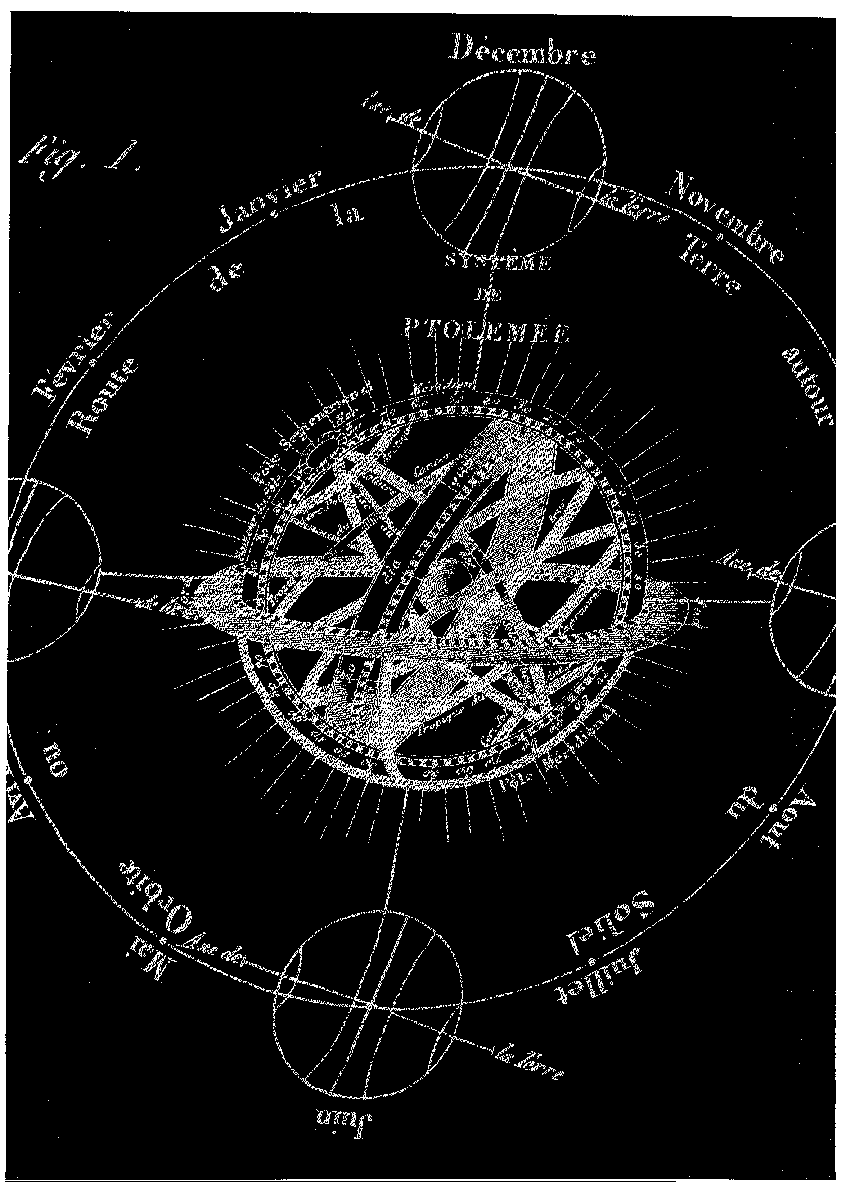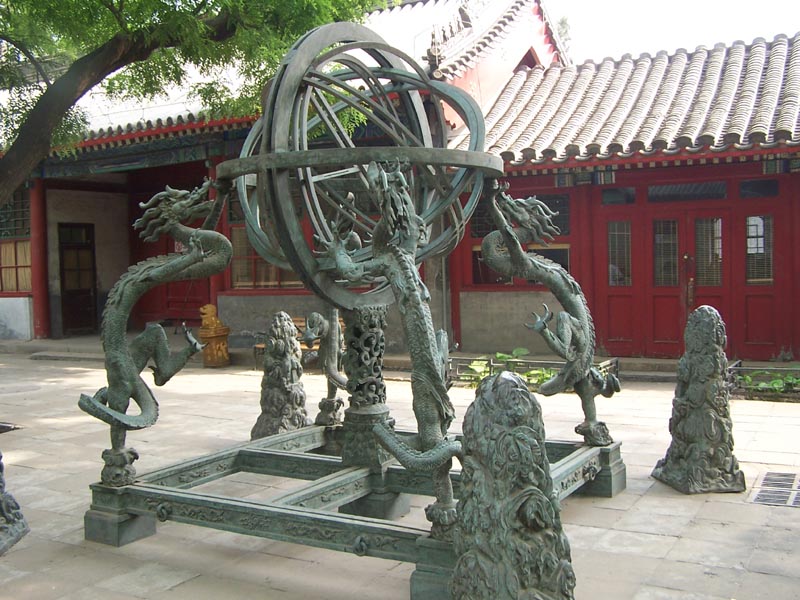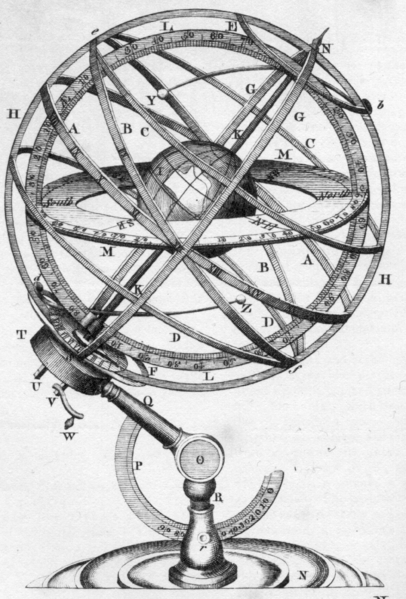- Tue 22 May 2007
- Astronomy
- #Astronomy, #Images
 I
recently had the pleasure of attending a friend's birthday party (Thanks
Kate) with another friend (Dane). During conversation Dane asked about
the meaning of the images on the front of his tee-shirt (right). Dane
had figured that parts of the imagery were related to the
zodiac and
the months of the year. What wasn't clear was whether the device in the
middle of the circle was just a meaningless ornament, or something of
astronomical interest.
I
recently had the pleasure of attending a friend's birthday party (Thanks
Kate) with another friend (Dane). During conversation Dane asked about
the meaning of the images on the front of his tee-shirt (right). Dane
had figured that parts of the imagery were related to the
zodiac and
the months of the year. What wasn't clear was whether the device in the
middle of the circle was just a meaningless ornament, or something of
astronomical interest.
The outer circle of the image on the tee is marked in French with the twelve months of the year. Inside that ring is the inscription 'Orbite ou route de la terre autour du soliel' meaning something like 'Orbit or road of the earth around the Sun' (Soleil is the modern spelling). The other marking 'Sytème de Ptolemée' indicates that the diagram is of the Ptolemaic System (or geocentric system). The four circular symbols at March, June, September, and December depict the Earth, its equator, tropics and polar circles, and its orientation to the sun at this time.
 The
device in the middle is an
armillary
sphere (a term that escaped me on the night). The armillary does indeed
have an astronomical purpose in that it is an abstract representation of
the sky and the paths of objects in it, particularly the Sun. The
armillary was developed by the Greeks around the third century BCE, and
the Chinese around the first century BCE although simpler devices
existed prior to this. The device can be used to make astronomical
measurements of star positions, as the ancient Chinese, Greeks and
Ptolemy
did, or as a navigational aid. Many armillary spheres have a purely
instructional purpose, demonstrating the relationship between various
points, planes, and paths in identification of points in the sky.
Armillaries are fairly common as purely ornamental objects.
The
device in the middle is an
armillary
sphere (a term that escaped me on the night). The armillary does indeed
have an astronomical purpose in that it is an abstract representation of
the sky and the paths of objects in it, particularly the Sun. The
armillary was developed by the Greeks around the third century BCE, and
the Chinese around the first century BCE although simpler devices
existed prior to this. The device can be used to make astronomical
measurements of star positions, as the ancient Chinese, Greeks and
Ptolemy
did, or as a navigational aid. Many armillary spheres have a purely
instructional purpose, demonstrating the relationship between various
points, planes, and paths in identification of points in the sky.
Armillaries are fairly common as purely ornamental objects.

In early armillary spheres the object at the centre represented the
Earth because everybody knew the Earth was the centre of the Universe.
Some later spheres depict the Sun at the centre after the
Copernican
view. The Earth is supported by a rod that forms the north-south axis of
rotation and points to the north and south celestial poles. Surrounding
the central object are a series of rings of various sizes and
orientations and sometimes an object representing the
Moon. The exact
numbers of rings vary from device to device although the major ones are
always present.
The rings can be divided into two groups; the great circles and others. There are typically five great circle rings:
- The projection of the Earth's equator to form the celestial equator (Label A). This ring lies on a plane perpendicular to the axis through the Earth and is often marked with twenty-four divisions representing the hours of a day and used to identify the right ascension of an object. Right ascension is analogous to longitude on the Earth's surface.
- The meridian ring (Label L), mounted on the top and bottom of the axis rod and crossing the equatorial ring at right angles. This ring is typically marked in degrees from zero at the equator through to 90 at the poles and is used to indicate the declination of a point in space. Declination is the astronomical equivalent of latitude on the Earth's surface.
- The apparent path of the Sun through the sky over a year is represented by a ring (Label B) mounted at an angle of approximately 23 degrees to the equatorial ring. The angle comes from the tilt the Earth's axis has. The ring is marked, often ornately, with twelve divisions representing the zodiacal constellations and its width may represent the range in which the Moon and classical planets wander in (23 plus/minus 9 degrees). This ring lies in a plane called the ecliptic plane. Aries is aligned with the intersection of the equatorial ring where this ring passes from the southern to northern hemisphere.
- The equinoctial colure (Label G) passes through the two poles and the intersection of the equatorial and ecliptic rings. Equinoctial means "equal night", is related to the term equinox, and identifies the location of the Sun on two days when day and night are of equal length (roughly 20 March and 23 September).
- The solsticial colure (Label H) passes through the two poles and is perpendicular to the equinoctial colure. Its intersection with the ecliptic ring identifies the location of the Sun at its northern- or southernmost point in the sky during the year. These times are called the solstices and are approximately 21 June and 22 December. These are the longest and shortest daylight periods of the year.
Often a disc is present to represent the local horizon of the observer (Label M). The sphere can be mounted on a movable stand (as in the diagram) to allow it to be tilted and rotated for use at various latitudes and times.
Smaller rings are mounted to represent:
- The antarctic and arctic circles. These rings are parallel to the equator and approximately 23 degrees from the poles.
- The Tropic of Cancer approximately 23 degrees north of the equator and coincident with the northernmost excursion of the ecliptic. The name comes from the position of the Sun in the constellation Cancer at the June solstice... at least it was when the name was given. The Sun is now in Taurus at the June solstice because of the effect of precession.
- The Tropic of Capricorn approximately 23 degrees south of the equator and coincident with the southernmost excursion of the ecliptic. The naming rationale is similar to that for the Tropic of Cancer except for the December solstice (now Saggitarius).
The armillary sphere also makes a stylised appearance on the Portugese flag. Officially it symbolises the seafaring prowess of the Portuguese throughout history and particularly during the reign of King Manuel I (1495–1521) when Portugal was a major maritime leader. Astronomical observation and instruments like the armillary has a long history in navigation, particularly at sea where there are no landmarks. The sphere also features prominently in Portuguese Manueline architecture.
Want to build yourself an armillary sphere? Try here.
Clear skies!
